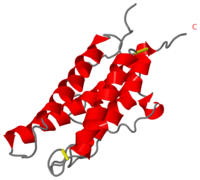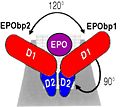User:Gourinchas Geoffrey/Sandbox 205
From Proteopedia
| Line 20: | Line 20: | ||
== Biological role == | == Biological role == | ||
| - | '''L'Erythropoietin''' is a glycosylated hormone mainly secreted in the kidneys (90%) and little in the liver. | + | The gene of the erythropoietin was cloned at the man's, the mouse and the monkey. It is located at the man's on the chromosome 7 in the region q21. It contains 5 exons and 4 introns. The gene is very preserved according to the species. It exists 94 % of homology between the human gene and the monkey gene and 80 % of homology enters the murin gene and the human gene. |
| + | '''L'Erythropoietin''' is a glycosylated hormone mainly secreted in the kidneys (90%) at the level of the cortex and of external medullary, and little in the liver. This hormone acts on the target cells by the intermediary of a specific receptor essentially on the erythroblastique progenitor, and a little on megacaryocyte progenitor. Through experiences of connection with the market hormone, it was demonstrated the existence of a single receptor (high affinity) or two types of receptor of high and low affinity. After the binding with its receptor, the Erythropoietin specifically leads the phosphorylation of the receptor on the tyrosine, from the first minutes which follow its connection. | ||
The secretion of this hormone depend of '''the partial pressure of dioxygen''' in the kidney cells. Indeed, if there is a diminution of the dioxygen pressure, the number of red blood cells decreases, for example when your are at high altitude, or if you are a big hemorrhagic wound. Thus needs of dioxygen of the tissues increase and thus the secretion of Erythropoietin is stimulated. | The secretion of this hormone depend of '''the partial pressure of dioxygen''' in the kidney cells. Indeed, if there is a diminution of the dioxygen pressure, the number of red blood cells decreases, for example when your are at high altitude, or if you are a big hemorrhagic wound. Thus needs of dioxygen of the tissues increase and thus the secretion of Erythropoietin is stimulated. | ||
| Line 26: | Line 27: | ||
To increase the number of red blood cells, this hormone stimulate the proliferation of stem cells precursor of erythrocyte in the bone marrow which will became red blood cells. | To increase the number of red blood cells, this hormone stimulate the proliferation of stem cells precursor of erythrocyte in the bone marrow which will became red blood cells. | ||
| + | For regulate the expression of the Erythropoietin, there are activating regulating sequences in 3 ' of the gene as well as the sequences in 5 ' which are specific of tissue. On the other hand, recent works suggest that a heminique protein would play a regulating role on the transcription: if the tissular oxygenation is adequate, this protein fixes the oxygen and inhibits the transcription of Erythropoietin. | ||
| + | |||
| + | In the absence of oxygen, the deoxygenated shape of this heminique protein could lead the production of the Erythropoietin. | ||
'''The glycosylation''' of this hormone allows his solubilisation in the blood and his carry towards his target, the bone marrow. | '''The glycosylation''' of this hormone allows his solubilisation in the blood and his carry towards his target, the bone marrow. | ||
Revision as of 10:52, 23 December 2011
Contents |
HUMAN ERYTHROPOIETIN
|
The Erythropoietin hormone is a glycoprotein which is involved in Erythropoiesis, which is the red blood cells production. It allows the differenciation of the erythrocyte precursors in the bone marrow.
Biological role
The gene of the erythropoietin was cloned at the man's, the mouse and the monkey. It is located at the man's on the chromosome 7 in the region q21. It contains 5 exons and 4 introns. The gene is very preserved according to the species. It exists 94 % of homology between the human gene and the monkey gene and 80 % of homology enters the murin gene and the human gene. L'Erythropoietin is a glycosylated hormone mainly secreted in the kidneys (90%) at the level of the cortex and of external medullary, and little in the liver. This hormone acts on the target cells by the intermediary of a specific receptor essentially on the erythroblastique progenitor, and a little on megacaryocyte progenitor. Through experiences of connection with the market hormone, it was demonstrated the existence of a single receptor (high affinity) or two types of receptor of high and low affinity. After the binding with its receptor, the Erythropoietin specifically leads the phosphorylation of the receptor on the tyrosine, from the first minutes which follow its connection. The secretion of this hormone depend of the partial pressure of dioxygen in the kidney cells. Indeed, if there is a diminution of the dioxygen pressure, the number of red blood cells decreases, for example when your are at high altitude, or if you are a big hemorrhagic wound. Thus needs of dioxygen of the tissues increase and thus the secretion of Erythropoietin is stimulated.
On the contrary, an increase of the pressure of dioxygen decrease the secretion of Erythropoietin.
To increase the number of red blood cells, this hormone stimulate the proliferation of stem cells precursor of erythrocyte in the bone marrow which will became red blood cells. For regulate the expression of the Erythropoietin, there are activating regulating sequences in 3 ' of the gene as well as the sequences in 5 ' which are specific of tissue. On the other hand, recent works suggest that a heminique protein would play a regulating role on the transcription: if the tissular oxygenation is adequate, this protein fixes the oxygen and inhibits the transcription of Erythropoietin.
In the absence of oxygen, the deoxygenated shape of this heminique protein could lead the production of the Erythropoietin. The glycosylation of this hormone allows his solubilisation in the blood and his carry towards his target, the bone marrow.
Structure
| |||||||||||
αα


